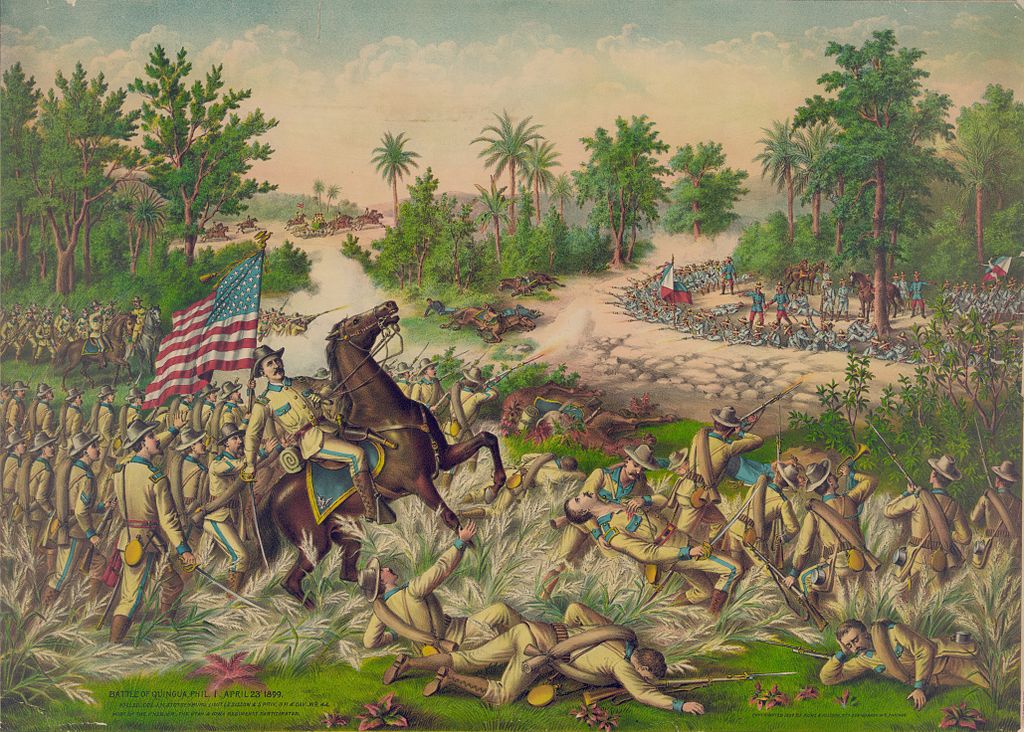Philippine-American War: April 1899, the advance north in slow motion

Battle of Quingua: April 23, 1899. CONTRIBUTED
When the American forces commenced their northern attack on General Emilio Aguinaldo’s troops on March 25, 1899, the operation took only six days to capture the Philippine capital of Malolos on March 31, 1899. The distance from the American entrenchments outside of Manila to Malolos in Bulacan Province was approximately 23 miles.
The American advance north after the capture of Malolos was considerably slower. It took the Americans twenty-seven days, April 1, 1899, to April 27, 1899, to advance approximately 8 miles from Malolos to Apalit in Pampanga Province.
The American optimism of a short war was shattered. There were numerous peace overtures during the month of April 1899 by both parties, but the Americans held firm to an unconditional surrender by the Filipinos. For safety purposes, the Philippine government had retreated to San Fernando in Pampanga Province. However, Emilio Aguinaldo and the Philippine cabinet and government were not even contemplating an unconditional surrender. The war continued.
April 1, 1899, was a beautiful sunny day with relatively mild temperatures. The American soldiers in Malolos were exhausted from the six days of continuous combat. The logistical problems that plagued the Americans during the last six days in March 1899 were beginning to abate. The northern railroad from Manila to Malolos was routinely bringing supplies. The American soldiers had plenty of rations. The American volunteers were even able to exchange their less effective Springfield rifles for Krag Jorgensen rifles.
April 1899 was also a time for American troop rotations. There was a significant number of American soldiers arriving in the Philippines. The volunteer regiments who had enlisted for the Spanish-American War and had been stationed in the Philippines since July 1898 were being replaced with fresh U.S. volunteer and regular army soldiers.
On the outskirts of Malolos, the American soldiers were ordered to develop a series of outposts surrounding the west, east and north sections outside the former capital. In addition, the American soldiers combed the areas surrounding Malolos looking for discarded or hidden Philippine weapons and ammunition.
Shortly, the American outposts were attacked by Aguinaldo’s forces. On Thursday, April 6, 1899, the Filipinos attacked several of the outposts. The Filipinos were targeting outposts with significant American artillery assets.
On Saturday, April 8, 1899, there was a major attack by Aguinaldo’s troops on American outposts. The intense attack lasted until Sunday, April 9, 1899. The Americans were finally able to repel the attack. There were numerous dead and wounded soldiers on both sides. The American wounded were transported by the railroad to hospitals in Manila.
During the second week of April 1899, the Filipino forces attacked an American outpost on the east side of Malolos. Obviously with these routine and intense attacks, Aguinaldo’s troops were not giving up, and the war was not waning.
Also, during this time of conventional warfare outside of Malolos, there was also guerrilla raids on American soldiers who were traveling from Malolos to Manila or Manila to Malolos. This guerilla activity was behind the supposedly pacified American lines. These actions support the argument that conventional and guerilla warfare were occurring simultaneously.
The first major battle north of Malolos transpired on April 23, 1899. The conflict in Bulacan Province was called the Battle of Quingua (called Plaridel today). General Gregorio del Pilar was the commanding officer for Aguinaldo’s troops. The battle was a combination of cavalry and infantry attacks. General del Pilar won the initial phase against the United States cavalry. American infantry was eventually able to defeat the Philippine forces.
During the cavalry attack, a senior American officer named Colonel John Stotsenburg was killed. To honor his service during the battle, the United States War Department established Fort Stotsenburg as a very large military reservation in Central Luzon. In 1919, a section of Fort Stotsenburg was transferred to the U.S. Army Air Corp. The airfield was named Clark Field after Major Harold Clark who had died during an aircraft accident in the Panama Canal Zone. After World War II, Clark Field and Fort Stotsenburg were merged into Clark Air Force Base.
One of the biggest obstacles that the Americans encountered heading north from Malolos was the Rio Grande (now called the Pampanga River) and a tributary of the Rio Grande called the Bagbag River.
On April 25 to 26, 1899, the Battle of Calumpit raged in this river area. Initially, the advantage favored the Filipinos since they held defensive positions across the rivers. However, the tide turned in favor of the Americans. Complicating the situation, senior Filipino officers had major disagreements on tactics. The Americans were able to cross the rivers and head into Apalit in Pampanga Province on April 27, 1899.
On April 28, 1899, in the town of Apalit, the Americans again demanded an unconditional surrender by the Philippine government but was rebuffed. The war was not coming to an end anytime soon.
Dennis Edward Flake is the author of three books on Philippine-American history. He is Public Historian and a former park ranger in interpretation for the National Park Service at the Eisenhower National Historic Site in Gettysburg, PA. He can be contacted at: flakedennis@gmail.com

